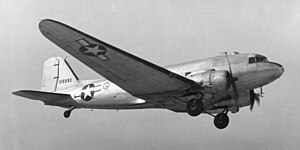Douglas R4D Skytrain
| C-47 Skytrain C-53 Skytrooper Dakota |
|
|---|---|
 |
|
| Role | Military transport aircraft |
| National origin | United States |
| Manufacturer | Douglas Aircraft Company |
| Designer | Douglas Aircraft |
| First flight | 23 December 1941 |
| Status | In service in Colombia, Greece, El Salvador and South Africa |
| Primary users |
United States Army Air Forces Royal Air Force United States Navy Royal Canadian Air Force See operators |
| Number built | 10,174 |
| Developed from | Douglas DC-3 |
| Variants |
Douglas XCG-17 Douglas AC-47 Spooky |
The Douglas C-47 Skytrain or Dakota (RAF designation) is a military transport aircraft developed from the civilian Douglas DC-3 airliner. It was used extensively by the Allies during World War II and remains in front line service with various military operators.
The C-47 differed from the civilian DC-3 in numerous modifications, including being fitted with a cargo door, hoist attachment, and strengthened floor, along with a shortened tail cone for glider-towing shackles, and an astrodome in the cabin roof.
The specialized C-53 Skytrooper troop transport started production in October 1941 at Douglas Aircraft's Santa Monica, California plant. It lacked the cargo door, hoist attachment and reinforced floor of the C-47. Only a total of 380 aircraft were produced in all because the C-47 was found to be more versatile.
During World War II, the armed forces of many countries used the C-47 and modified DC-3s for the transport of troops, cargo, and wounded. The U.S. Naval designation was R4D. More than 10,000 aircraft were produced in Long Beach and Santa Monica, California and Oklahoma City, Oklahoma. Between March 1943 and August 1945 the Oklahoma City plant produced 5,354 C-47s.
The C-47 was vital to the success of many Allied campaigns, in particular those at Guadalcanal and in the jungles of New Guinea and Burma, where the C-47 (and its naval version, the R4D) made it possible for Allied troops to counter the mobility of the light-travelling Japanese army. Additionally, C-47s were used to airlift supplies to the embattled American forces during the Battle of Bastogne. Possibly its most influential role in military aviation, however, was flying "The Hump" from India into China. The expertise gained flying "The Hump" was later be used in the Berlin Airlift, in which the C-47 played a major role, until the aircraft were replaced by Douglas C-54 Skymasters.
...
Wikipedia
